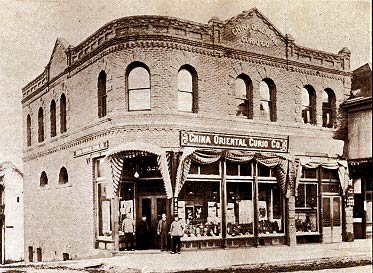
A Visit to Old Los
Angeles
2. East of Main Street
by
Brent C. Dickerson
Copyright © Brent C. Dickerson
Index to Episodes (click here)
Chinatown; Little Tokyo; the area east of Main,
predominantly commercial and industrial: Alameda St., Central Ave., San
Pedro St., Los Angeles St.
• Before returning to Main
Street, we look at the precincts between Main Street and the railroad
tracks. East of the old Plaza, along Alameda Street, was Los Angeles'
original Chinatown (extending to the present site of Union Station),
adding to the varying exoticism which greeted visitors. Los Angeles has,
since its beginning, been a dynamic community gaining strength from its
wide diversity. Immediately east of the old Plaza, at the western edge of
Chinatown, and facing the old church across the Plaza, is the China
Oriental Curio Company, on the southeast corner of Marchessault Street and
Los Angeles Street.

• Immediately next door to the south, and facing the middle of the east side of the Plaza, was the Canton Bazaar. This building was originally the town home of the Lugo family during the Mexican and early Yankee eras. The Lugo family then donated it to the Catholic Church, which used it for the original home of St. Vincent's College. The college later moved across town.
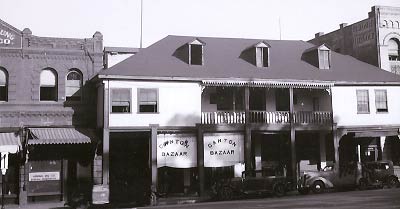
| • As we strolled into the community, this procession stopped us for a moment. "They don't look very happy," said young Frederick Johan, digging into his pocket; "I could give them some peanuts!" "Stand by silently," said Papa, "silently." | 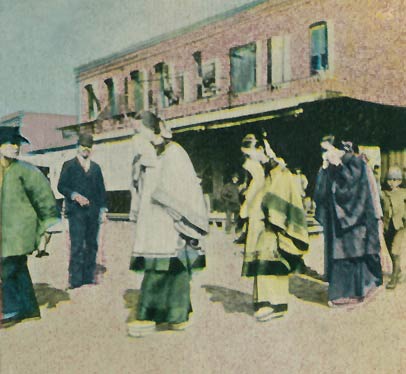 |
• But stepsister Anna could not take her eyes off of the family members just around the corner from the procession. Note the man's long queue.
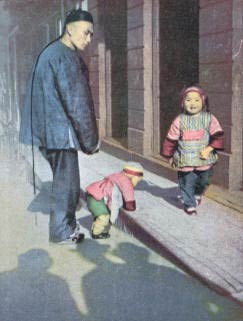 | 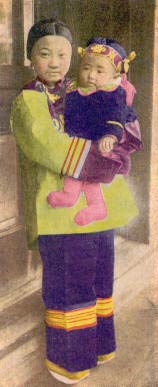 |
• But there is no
community without communication. The walls of buildings
along public sidewalks provide a convenient place for news and
announcements. This bulletin board wall was located
on Marchessault Street near Alameda Street.
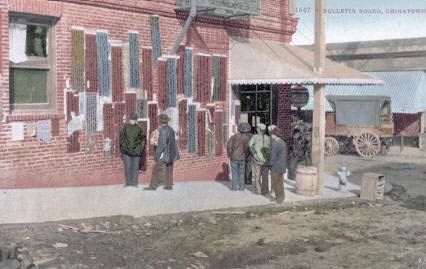
• The touches of exoticism made it very seductive...
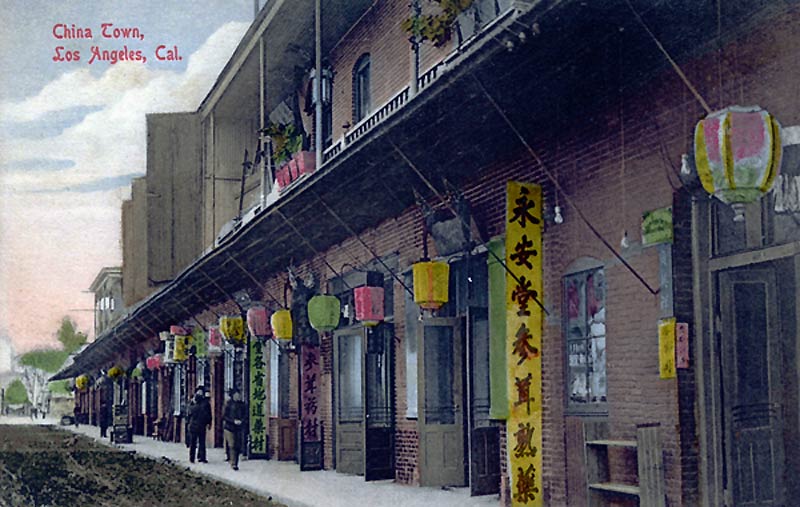
• Young Frederick Johan and I penetrated a bit deeper into the shadows and side-streets of Chinatown. This is looking east on Apablasa Street from Alameda.
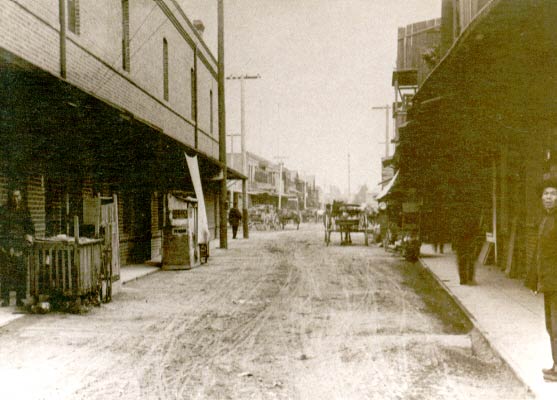
| • FJ suddenly stopped and said, "Take away the Chinese lanterns and signs, and it's any frontier town..." I realized that this was the last bastion of Los Angeles as it was in the 1850s! I could see the cowhands loafing along the boardwalks, the pretty señoritas with their duennas looking in the shop windows as they passed for some exciting new fashion to wear, the farmers loading their wagons with new-bought supplies. How many youthful noses had pressed against these windows over the decades, their owners curious to see the doings of the grown-ups inside, or perhaps hungering after sweets or toys to be desired but never possessed? How many litigants, depositors, projectors, salesmen, job-seekers had looked on these doors and sighed a deep sigh as they grasped the knob, seeing a potentiality for a change in fortune or life—which was probably not to happen? Perhaps these children and these adults were not so different after all! | 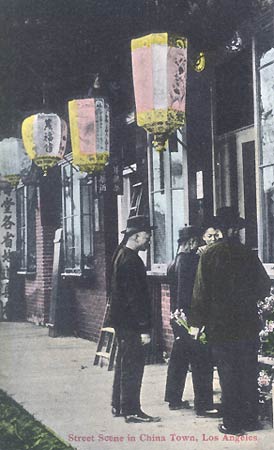 |
• A small boy, hardly able to choose between shyness and curiosity, gazed at us from a grocery shop. (More Chinatown at Episode 16.)
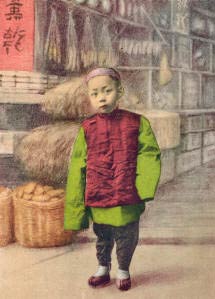
• Diversity of another sort:
An unexotic neighbor to the north of Chinatown and the Plaza, the Columbia
Brass Works could be found at 717 N. Main Street. At
other times, the company could also have been found
at 810 N. Main, and at 688 Rio Street.
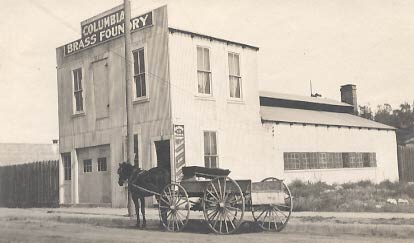
• The area east and north of Chinatown and the Plaza had an air of abandonment inbetween the factories. You might see an old adobe here, melting under half a century of neglect and rain; there you'd see a vacant lot, grassy furrows in the dirt being vague memories of someone's efforts—to do what?—decades ago. Here and there would be vacant-eyed or nervous wanderers, in no hurry to do the nothing of their everyday lives. A few blocks from the brass works, near a place called Naud's Junction, we ran across this fine fellow. Anna said, with that modest tone of admiraton peculiar to her, "He looks like a man of the earth." Minnie turned up her nose and exclaimed, "Man of the earth!?! Yes, he certainly looks as if you could grow something on him!" Papa meantime had stepped over to him, admired his animal, and purchased something from his basket. Young Frederick Johan whispered to me, "I hope he's not seelling manure..." As Papa returned and we continued our walk, Mother took Papa by the arm. "What on God's green earth have you bought, Mr. S.? No more cigars, please." Papa held up a bunch of leaves tied in a bundle with a bit of raffia. "This, Mrs. S., is the finest Los Angeles watercress you shall find anywhere on Earth." "Or indeed off the Earth as well, I should think," I added. Mother threw up her hands. "Oh, Mr. S., is there a salesman anywhere who can't sell you something?"
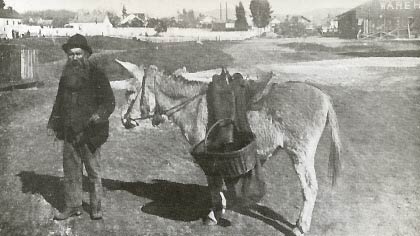
• The Pilgrim Iron Works proudly proclaimed its new headquarters in 1909 at the corner of Macy St. and Date St., just off Alameda Street, and two blocks east of Main—indeed, two blocks northeast of the Plaza (on the present site of Terminal Annex).
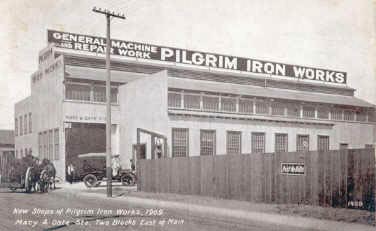
• Date Street curves around in a north then northwest direction, nearly reaching North Main Street but stopping short. The parcels between the end of Date Street and N. Main Street are occupied by the Lacy Manufacturing Company, at 1000 N. Main, and the Llewellyn Iron Works, at 1200 N. Main. Here they are, with a little bit of N. Main Street itself. The Lacy Manufacturing Company specialized in metal pipes for civic and industrial purposes, and was founded by William Lacy, an Englishman who came to L.A. in 1877. Via Sullivan's brother Frederick, who married Charlotte Louisa Lacy, Lacy was the brother-in-law of Sir Arthur Sullivan, of Gilbert and Sullivan fame, and indeed hosted Sir Arthur at his home in L.A. in July of 1885, at which time Sullivan "expressed himself in no measured terms about the natural beauties of Los Angeles. But he wondered why somebody didn't build a first-class hotel here" [Los Angeles Times of August 1, 1885].
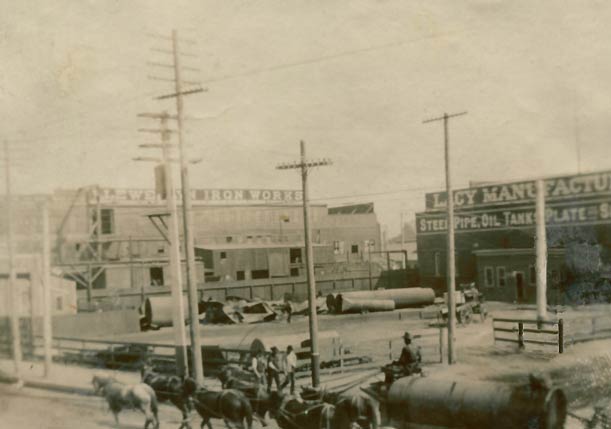
• Nearby, at 1435 N. Main Street, is Engine House No. 19. (Cruddy background courtesy of original postcard photo lab.)

• Farther north and east, near the river, are rail yards and rail shops.
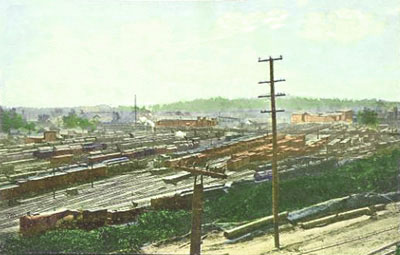
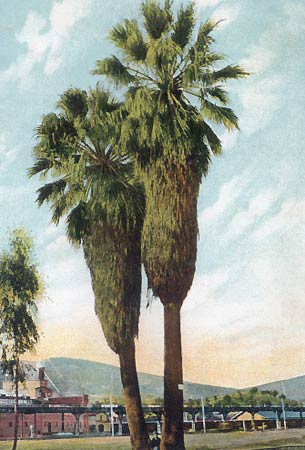 | • Also near the river, but north of the Plaza, is the Capitol Milling Company, which processes flour, and is housed in the brick buildings we see behind the palm trees. The field in front, known as The Cornfield, has had a long and rich career of service to the city. The original channel of water to the city, the Zanja Madre, ran through the field from the river to the settlement. Later, the field was turned to agricultural uses, and later yet was assimilated into the railroad yards. The viaduct which can be discerned between the field and the buildings belongs to the Los Angeles Cable Railway Company, later known as the Pacific Railway, in use from 1888 to 1904. |
• We return south on Alameda Street, taking us past China Town to the left and the Plaza on the right, then continue a block or so south to Aliso Street, where we pause and look eastward to the corner of Aliso and Vignes. This area, eastward to the Los Angeles River, had been an agricultural area, most particularly devoted to vineyards. Fifty years previous to our visit, an enormous ancient sycamore tree, an "Aliso," would have been prominent, a landmark older than the city's founding; it may be seen "off in the distance" in many old pictures. For years, it was protected in a courtyard of the Vignes wine establishment; ultimately, it died and was cut down when the acreage was subdivided for development. Here is an old close-up sketch by Edward Vischer, circa the 1860s-1870s, of Los Angeles' Aliso in its courtyard in Vignes' Aliso winery.
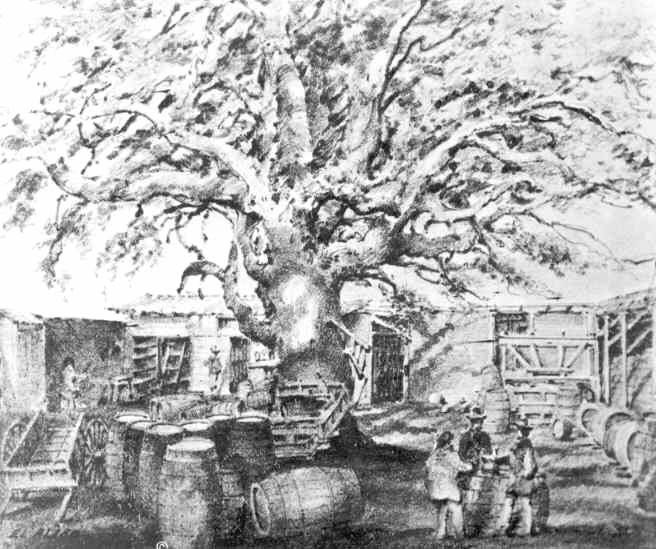
• At length, the Aliso winery became the Maier Brewing Company, at the same location: 440 Aliso Street.

• Aliso Street is just about a block out of the picture to the left in the image below, which shows one of the least photographed precincts of the downtown area. We are looking east towards the river and Boyle Heights. Originally an agricultural area, it was then subdivided for residences, which were then pushed out as the wholesale and warehouse districts expanded; only a very few houses can still be seen in this image (taken from the new City Hall tower in 1934). Below us, out of the picture, would be Los Angeles Street. The shadowy building closest to the lower left corner is the Newell Mathews Company at the northeast corner of Market Street and Los Angeles Street. A little beyond it, with a wall bathed in sunlight, are the premises of the Los Angeles Warehouse Company, an older building of which we will see more closely in a moment. The tank near upper left is at the northeast corner of Ducommun Street and Center Street, and was a familiar feature well into the freeway era. Moving to the right of the tank, we see the First Street Bridge crossing the river; to the right (south) of where the bridge meets the far bank of the river is where the Salt Lake Station was (this is the station at which our travelers would actually have arrived). We see the smokestack at center; a bit to the right of this can be seen the headquarters of the Los Angeles Soap Company (look for the set of buildings with large white lettering along the top edge), which was located north of where First Street meets Hewitt Street (we will see it close-up in a moment). Coming in closer on First Street, we see the low buildings of the Union Hardware & Metal Company on First between Alameda and Central. Finally, near the upper right corner can been seen the Fourth Street bridge over the river.
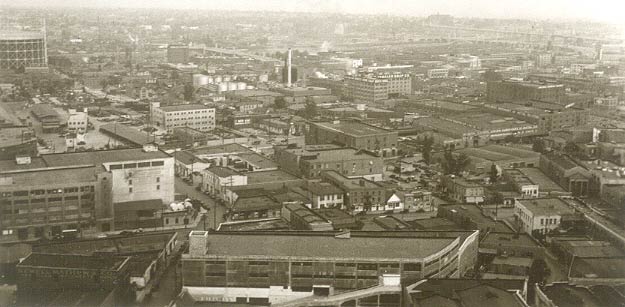
• Alameda's next cross-street to the south was in one period—about 1850 to 1870—the street of commerce in the little town, and so was named Commercial Street. At 316 Commercial Street, near its corner with Alameda, we find the Los Angeles Warehouse Company, certainly a very commercial and appropriate business to find on the street.
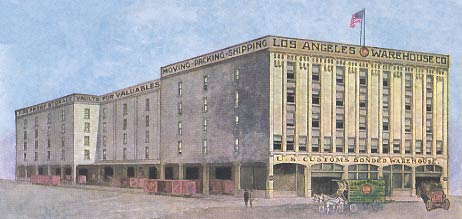
• Continuing south along Alameda, still in what had been the oldest commercial district, we come to First Street and shift one block west to the corner of First and Central Avenue, from which we look west along First toward the heart of downtown—Los Angeles Street, Main Street, Spring Street, and Broadway. In the far distance, barely discernible, First Street climbs Bunker Hill; in due course, we will stand at that point and look back along First to where we are now. We have entered what was, at the time of our family's visit, another ethnic enclave; this was fast becoming Los Angeles's Little Tokyo.
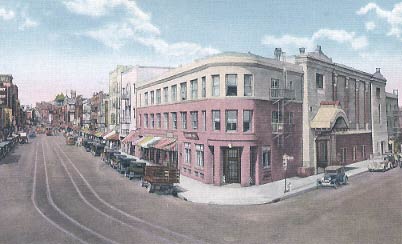
• See those First Street trolley tracks in the above picture? We see them going to the west in the image; but turn around and follow them to the east, and they'll take you to the intersection of First Street and Hewitt Street, where is located the Los Angeles Soap Company complex. This driver is waiting in front of it, ready to deliver us and any boxes we might have to the train station a few blocks farther east.
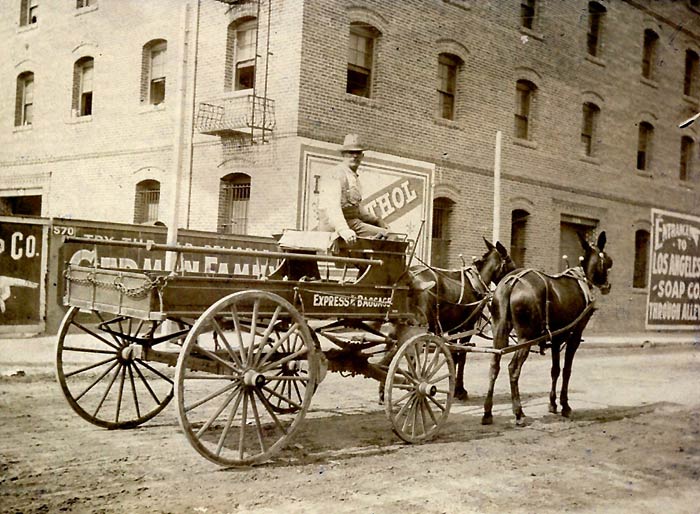
• We hop aboard the man's wagon and continue east on First Street to where it meets Santa Fe Avenue. On the southwest corner of that intersection is the local office of the Swift meatpackers people—right across the street from where we arrived, the domed Santa Fe railroad terminal, the main entrance of which is about half a block south on the east side of the street.
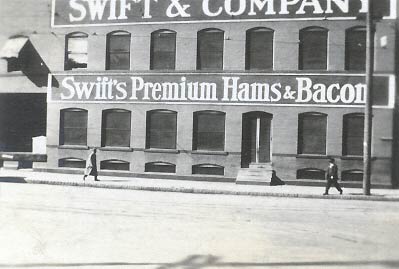
• About a block and a half southwest around the corner, on the latitude of Second Street, would be found the headquarters of the Richardson, Holmes & Lamb Company, dealers in fruit and produce, at 848 Stevenson Avenue. They considered themselves the "Largest and best equipped produce house west of Chicago."
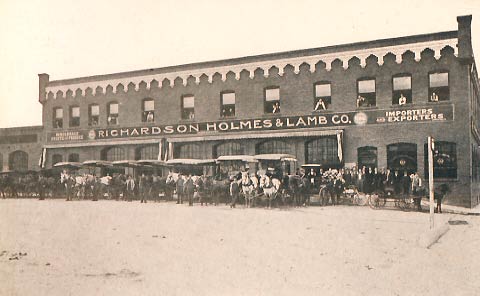
• If we would proceed west on Second Street to nearby San Pedro Street, and turn south, we would pass the elegant Wallace Woodworth home, with its unique observatory-cupola. In this north-looking view, we see it in the middle distance from farther south along San Pedro Street. The street we see on this side of the house, going right, then obscured by the traffic, is a short stub called Azusa Street. Woodworth was a prosperous and hard-working long-time Angeleno, going back to before the boom times, and the presence of his fine residence in this part of town where few such were to be found reflects the "build-anywhere" sensibility of an earlier era. Note that the signs in the view, on the buildings at the left, were covered over with horse-blankets, doubtless at the behest of the photographer who didn't want their distraction in the scene.
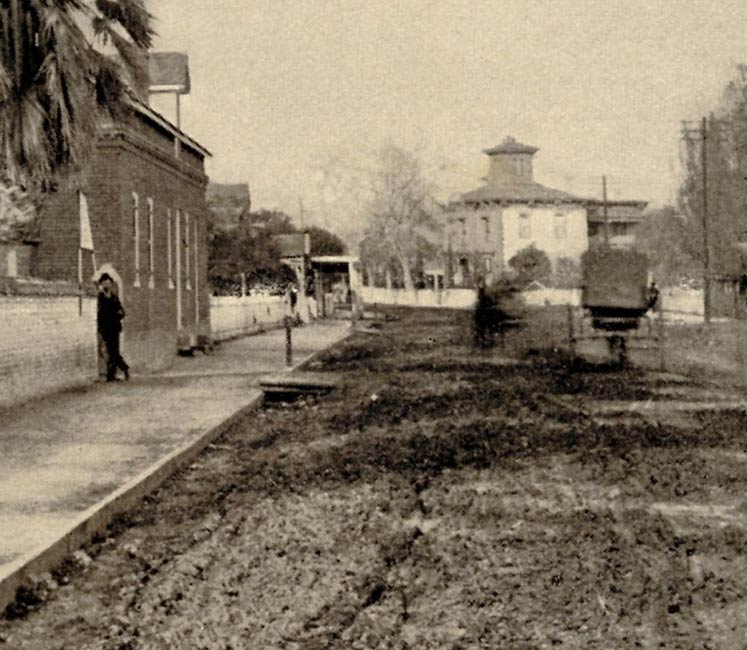
• Continuing south on San Pedro Street, we see its west side, between 2nd and 3rd Sts. We faintly see the tower of St. Vibiana's on Main St. in the distance in a break between some trees. The handsome palm trees were planted in the 1880s by William A. Hammel at his home. Hammel was Sheriff 1899-1902 and 1907-1914. One of the palms he planted was subsequently moved to the Southern Pacific Arcade Depot, and we'll see it shortly...

• Boyd Street is parallel to, and between, 3rd and 4th Sts.; and so, about a block from the above, on the south side of Boyd just a lot or two west of its corner with San Pedro Street, is the Wykoff House. "The Wykoffs seem to need an abnormally large house, and a lot of windows," quoth Minnie, with an expression midway between suspicion and admiration. " 'Tis a sort of poor house, I'd say," said Mother, whose attention had been caught by a notice posted on the fence near the entrance; "Here a man with an address in one of the rooms here says he's old but fit and ready to work at anything anyone will set him to." Papa got a sad look on his face, and said—quietly, to himself—"God bless him!"
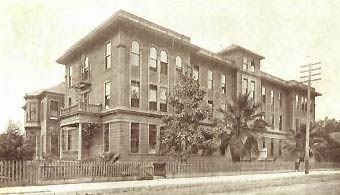
• Two blocks south down San Pedro Street, at address 443, just one lot past its corner with Winston Street, we passed this cozy little house, where our driver, who had to pick up deliveries back at the train station, set us down. (He didn't appear overly impressed with the tip Papa gave him.) From the sidewalk, Minnie scrutinized the two ladies who were coming out the door just as we commenced to continue our wanderings on foot. "Well," she whispered to me, "they do know how to dress here." Charley overheard. "Doubtless they pull it on one leg at a time," said he, without precisely stating what "it" might be. Minnie couldn't let this pass by: "Mother, Charley's talking about women's naked limbs here in front of the whole world! —And pulling things onto them!" Mother gave Charley a withering look and said, "Oh, Charley—what next?!"
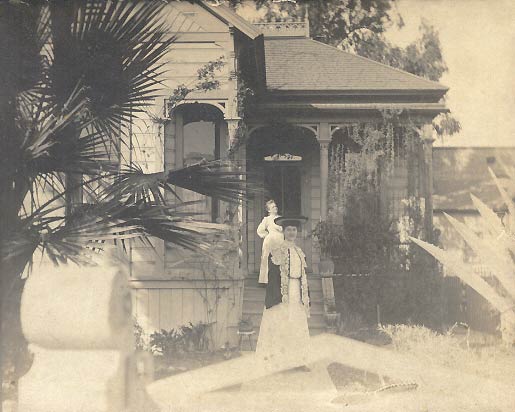
• Going on Winston Street a block away towards the west, we come to the Hotel Bixby at 433 Wall Street, the northwest corner of Wall and Winston Sts.

• A bird's eye view to the northeast over the wholesale district of the city. The street we see exiting the picture at lower right is Los Angeles Street; at about the center of the image would be the corner of Fifth Street and Los Angeles Street.
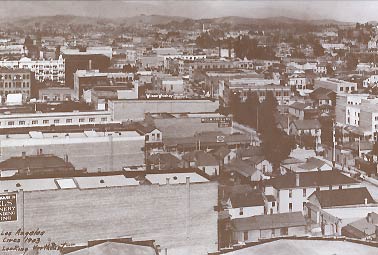
• The former agricultural area between the city and the river to the east was taken over largely by light industry and warehouses, with pockets of modest residential areas. Here, we look east on 6th Street; the market prominent below is at the southwest corner of 6th and Wall streets.

• Mere feet below the bottom left margin of the preceding image could be found the scene seen below at 221-223 E. 6th Street, between 6th's intersections with Los Angeles Street and Maple Avenue (that's Maple along the bottom of the preceding picture). Here we have a garage which is not only fireproof but absolutely fireproof, which I guess is better. Papa was much taken with the horses, and gave them some friendly pats as he looked them over; similarly, Minnie was much taken with the driver, but Mother kept her out of arm's reach. I wonder if "The Woodill Auto Co." really much liked having horses and a cart drawn up in front of their door!

• We continue south on Alameda and take a look or two at the Southern Pacific's Arcade Depot, dealing mainly in freight. The depot was well served by trolleys; for instance, after 1910 both the Pacific Electric and Los Angeles Railway systems provided service.
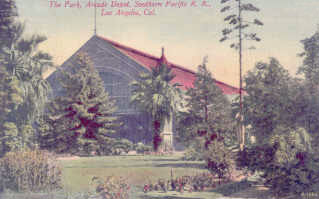
|

• Just about a block or so away, at the corner of 5th Street and Ruth Avenue, is the Hotel Morris. At the time of our family's visit, it was the St. Lawrence Hotel, comprised only of the taller building you see here; where the shorter building is was stables at that time. "A room adjoining the stables is a bit too much like home!" cried Minnie. Young Frederick Johan rejoined, "I see there are no windows on that side."
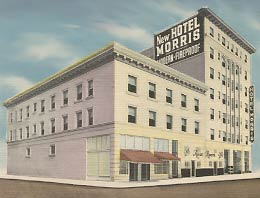
• A bucolic reminder of an
agricultural past, quiet Palmetto St. is nearby, heading from Alameda
Street down to the river. It would soon lose its country-lane look as
factory and commercial uses swept over the area.

• Once upon a time in the early days, it was looked on as a pleasure to leave town behind and go socialize under the grape arbors in this district.
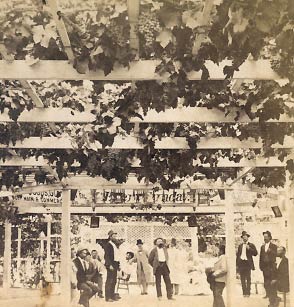
• Westwards a block or so from
Alameda, the next major north-south artery is San Pedro Street, one of the
oldest routes into and out of town, by which travelers arriving by ship in
the pre-railroad era would arrive from the harbor area, the coach drivers
adding enjoyment to their lives—and terror to the lives of their
passengers—by racing each other the score of miles to Los Angeles,
raising clouds of dust visible at their destination. No doubt a vestige of
this old delivery route, here is the San Pedro Street produce
market.
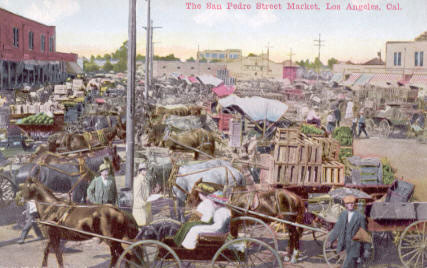
• We go another block west.
After our circuitous route, we finally return to Los Angeles Street, where
we began with the Chinese Curio Shop. We are now about two blocks south of
there. This is the building at 225 N. Los Angeles Street, where Temple
Street crosses (just to the left of the building).
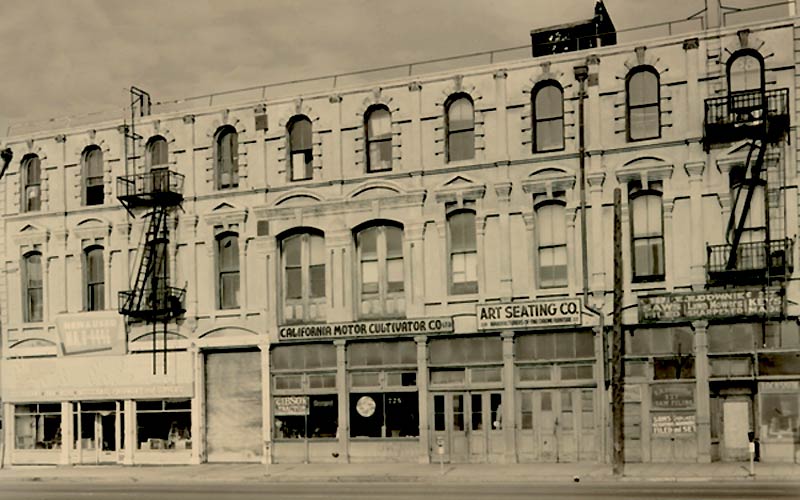
• We go another block south, and look north from Los Angeles Street's intersection with First Street. We are in the middle of the wholesale district. In the distance, the street seems to be blocked by buildings at Aliso St.; but it continues to the right of the buildings. The place where it seems to be blocked is the site where an incident famous in Los Angeles history, called the Chinese Massacre, commenced.
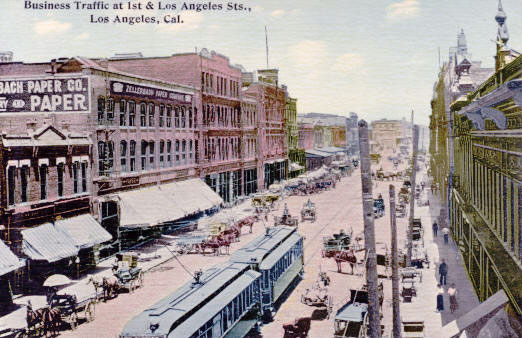
• From close to the corner with Second Street, we look north on Los Angeles Street again. You can see the previous image's prominent paper company wall-sign in the middle distance in this one. Some rabble-rouser was talking up a storm, drawing all sorts of people; but I couldn't hear what it was about.
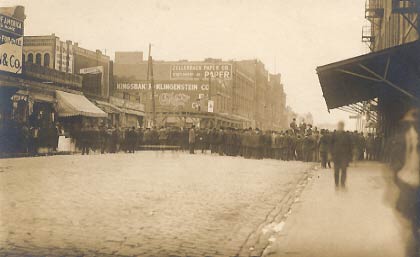
• Perhaps Papa can buy a cigar
or two at wholesale! But, on the whole, a dusty street of deliveries and
pick-ups, not of customers. We look north on Los Angeles Street from Third
St.
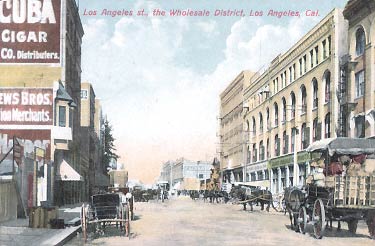
• Another block south on Los Angeles Street brings us to the Merchants' Liquor Company, at the northwest corner with Fourth Street. Charley mused, "I'd like to get into Liquor..." "Good heavens," said Minnie, "you're practically pickled already!"
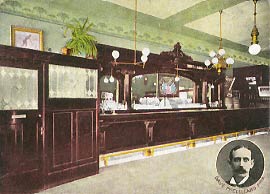 |  |

• No doubt a welcome and
convenient temporary home to many visiting wholesalers anxious to sell
their wares, the Baltimore Hotel, at the southwest corner of Fifth and Los
Angeles Sts. Formerly, the Baltimore Hotel was at the northeast corner of
Olive and 7th, on the other side of the downtown area; this new edition of
the Baltimore Hotel was built in 1910. Two buildings to the
right—that is, west on Fifth Street—we see a brick building with
white oriel windows projecting. This is the Charnock Block, built April to
October 1889, and located at the southeast corner of Fifth and Main
Streets.

• But before we leave the precincts of wholesalers and salesmen for that of everyday folks back on Main Street, let's take a rest in the lobby of the hotel across the street at the northwest corner of Fifth and Los Angeles Sts., the King Edward, built in 1905. As we see from the text on the cards, the proprietors of these hotels liked to tell people that they were near Main St.; but they were actually on Los Angeles St.
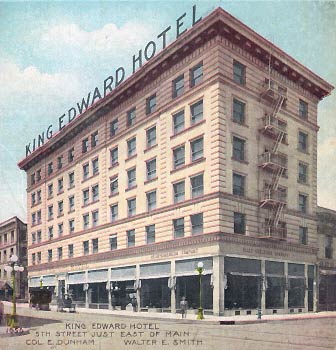
• When we were there, each and every rocking chair was occupied and in motion, back and forth . . . and back and forth . . . As I took in the scene, Anna looked at me and said, "Ulf, your face is becoming dreadfully chartreuse." Papa smiled wryly and declared, "Mrs. S., I fear our boy will never be an admiral." Mother looked at me and said, "Another bitter disappointment!" as Papa winked.
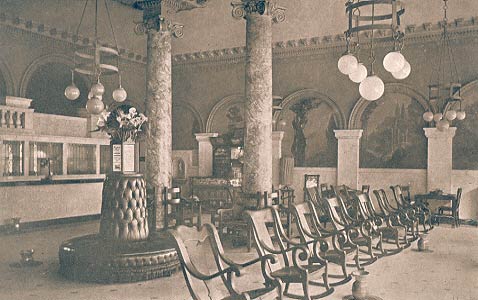
Return to Arrival and Plaza; or on to Main Street . . .